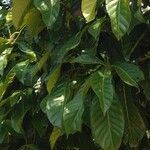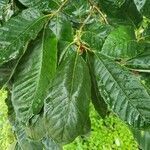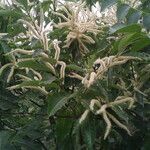A big tree. It grows 20-25 m tall. The trunk is 1 m across. The branches have short hairs but can also have long spreading hairs. The leaf stalk is 1-2 cm long. The leaf blade is oval and 10-17 cm long. It can be slightly hairy along the veins. The base of the leaf is rounded. There are coarse teeth around the edge. The male flower is 10-20 cm long. The cup is densely covered with spine like bracts. There can be 2-3 nuts in each cup. They are 2-3 cm across. The nuts are edible.




